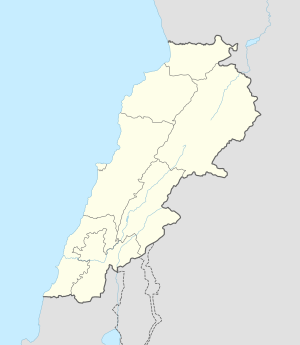Aishiya
This article needs additional citations for verification. (April 2022) |
Aaichiyeh
عيشية | |
|---|---|
Village | |
| Coordinates: 33°24′31″N 35°33′22″E / 33.40861°N 35.55611°E | |
| Grid position | 133/163 L |
| Country | |
| Governorate | South Governorate |
| District | Jezzine District |
| Elevation | 2,170 ft (660 m) |
| Time zone | UTC+2 (EET) |
| • Summer (DST) | +3 |
Aaichiyeh (Arabic: عيشية) is a village in the Jezzine District in Southern Lebanon. It is located 82 kilometers far from Beirut and on an altitude of 750 meters. The village is accessible by the roads of Nabatieh-Jezzine and Marjayoun-Jezzine. Its population is approximately 4000 people as of 2008. [citation needed]
Etymology[edit]
The name "aïchiye" (العيشية ) goes back to the word "live", which is the symbol of comfortable living and the surrounding pine trees and nature.[citation needed]
Religious sites
[edit]There are 2 churches in Aaichiyeh: Saint Anthony The Great (مار انطونيوس الكبير) Church, and the Church of the Lady (السيدة العذراء). "mar antonios al-kabir" 's church is built in 1901 ,making it the first church in "jabal al-rihan" region ,while the church of our lady of the immaculate conception, built in 1972 ,is nicknamed "noah's arc" because the villagers refuged in it during the massacre of 1976, fearing prosecution . Both churches were renovated at the conclusion of theLebanese Civil war (1975-1990) after being severely damaged by palestinian fractions and the israeli army .
Agriculture and nature
[edit]This article needs additional citations for verification. (October 2023) |
Aichiyeh is part of south Lebanon's agricultural regeon with rich and fertile soil, which makes its inhabitants dependent on raising livestock, bees, chickens, and growing olives and fruits such as grapes, peaches and apricots. The spring provides irrigation of cultivated lands. In the past, the villagers planted tobacco, a widespread crop at the time. Aaichiyeh is known for its abundance in oak and pine trees.[1]
History
[edit]This article needs additional citations for verification. (October 2023) |
The history of Aichiyeh dates back to the Phoenician period as vases were discoverd. This indicates that there was a previous Phoenician settlement in the area. During the Israeli occupation of southern Lebanon, the IDF had an army base in Aichiyeh.[2] In October 1976 the Aishiyeh massacres took place, ending with 70 Christian Lebaneas citizens murdered. The massacre was done by Palestinians belonging to the Syrian backed factions of Fatah and As-Sa'iqa.[3] On October 5th,1977 following the massacre, the village was attacked again by As-Sa'iqa that murdered 41 Christian citizens.[4] Today, Aichiyeh's people strongly support the Lebanese Armed Forces and good and strong relations between them.
landmarks and traditions
[edit]the pine forest of aichiye is greatly popular in the region ,while the most common place of gathering in the village is the place of the church of our lady ,especially on Sundays and events .also ,in commemoration to those who died during the massacre of 1976, the "martyrs 's square " was opened ,in addition to "the cedars forest " ,in which every cedar tree is dedicated to a martyr .Also, the "general's square "was opened in 2023 to honor the Lebanese army commander, general Joseph Aoun, a local from aichiye who is greatly respected among the locals. Prior to the civil war, there were 2 schools in the village that were later on converted to a base for the Lebanese army and a station for the lebanese civil defense .
Every year,on the 14th of august, the villagers celebrate the holiday of the Virgin Mary ,and on the 17th of january the holiday of Saint Anthony The Great .the most celebrated holiday the Feast of the Cross on the 14th of septembre .
References
[edit]- ^ "IDAL - Lebanon at a Glance - Invest in Regions - South Lebanon Governorate". IDAL.COM. Retrieved 2024-07-30.
- ^ Tveit, Odd Karsten (2010) Goodbye Lebanon. Israel's First Defeat. Rimal Publication. Translated by Peter Scott-Hansen. ISBN 978-9963-715-03-9 pp.295,300
- ^ Picard, Elisabeth (1976-01-03). "Liban: guerre civile, conflit régional". Maghreb-Machrek. 73 (3): 53–69. doi:10.3917/machr1.073.0053. ISSN 1241-5294.
- ^ American University, Lebanese (1970-01-01). "Environmental Terrorism in the Arab Gulf". Al-Raida Journal: 12. doi:10.32380/alrj.v0i0.1099. ISSN 0259-9953.
External links
[edit]- Aaychiyeh, Localiban


